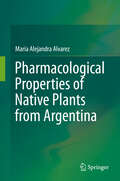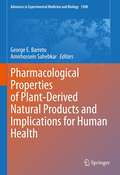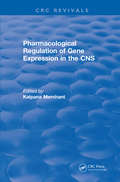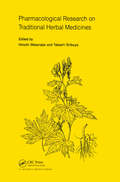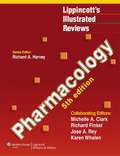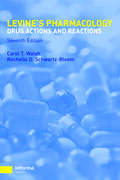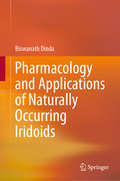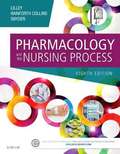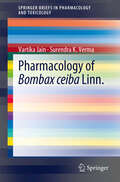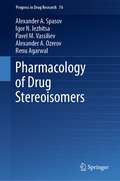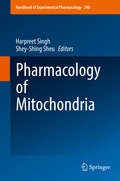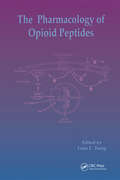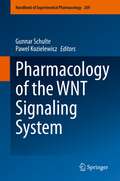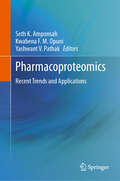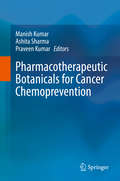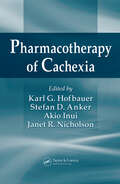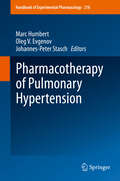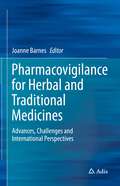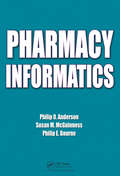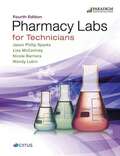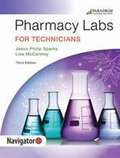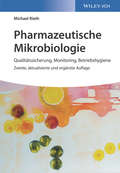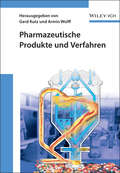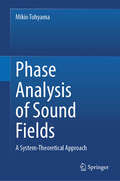- Table View
- List View
Pharmacological Properties of Native Plants from Argentina
by María Alejandra AlvarezThe aim of this book is to offer information about the Pharmacological Properties of Native Plants from Argentina to students, researchers and graduates interested in the fields of Ethnobotany, Pharmacognosy, Phytochemistry, Pharmacy, and Medicine. The book includes summary information about the native plants from Argentina with medical activity comprising their botanical characteristics, distribution, characteristics of the regions where they grow, ethnobotanical information, chemical data, biological activity, establishment of in vitro cultures, toxicity, and legal status.
Pharmacological Properties of Plant-Derived Natural Products and Implications for Human Health (Advances in Experimental Medicine and Biology #1308)
by George E. Barreto Amirhossein SahebkarMedicinal plants and their derived products remain as an indispensable source of bioactive molecules that serve as either drug candidates or lead compounds for drug design and discovery. There are several advantages for plant-derived therapeutics including wide availability, diverse pharmacological actions and a generally good profile of safety and tolerability. Over the recent years, there have been numerous reports from clinical studies testifying to the efficacy and safety of medicinal plants and phytochemicals in ameliorating several human diseases. A plethora of basic studies has also unravelled molecular mechanisms underlying the health benefits of herbal medicines. Nevertheless, issues such as identification of bioactive ingredients, standardization of the products and drug interactions remain to be further studied. In this book, we aim to put together several chapters on the medicinal properties and pharmacological action of medicinal plants, plant species and phytochemicals. The goal is to present a comprehensive collection on most of the therapeutic aspects of plant-derived natural products and molecular mechanisms thereof.
Pharmacological Regulation of Gene Expression in the CNS Towards an Understanding of Basal Ganglial Functions (CRC Press Revivals)
by Kalpana MerchantThis book focuses on dopamine-mediated regulation of gene expression within the striatum and associated regions of the central nervous system. It is an excellent review of experimental data on interactions between neuronal systems at systemic, cellular, and molecular levels. Each of the chapters, written by the world's leading scientists, provides an understanding of anatomy, neurochemistry, and cellular and molecular effects. Such an understanding sheds light on the pathophysiology of central disorders involving the basal ganglia and leads to new approaches for the treatment of diseases such as Parkinson's disease and schizophrenia, and also addictions to psychostimulants such as cocaine and amphetamines.
Pharmacological Research on Traditional Herbal Medicines
by Hiroshi WantanabeA concise overview of some of the findings and topics related to the pharmacology and clinical applications of traditional herbal therapeutics. It addresses the current and potential roles for herbal medicine in the context of our evolving health-care systems. Introducing many pharmacological advances made, the work also describes the modern theories and scientific methodologies applied to today's studies on herbal medicines and new drug development.
Pharmacology
by Richard A. Harvey Michelle A. Clark Richard Finkel Jose A. Rey Karen WhalenLippincott's Illustrated Reviews: Pharmacology, Fifth Edition enables rapid review and assimilation of complex information and focuses on the essentials of medical pharmacology. Clear, sequential pictures present mechanisms of action and actually show, rather than tell, students how drugs work. This book features a signature outline format with more than 500 full-color illustrations and cross-references to other volumes in this bestselling, student-oriented series.
Pharmacology: Drug Actions and Reactions
by Carol T. Walsh Rochelle D. Schwartz-BloomCompletely revised and updated, this is the seventh edition of Levine's classic pharmacology textbook. Known for it's thorough coverage and intelligent organization, the book covers the basic principles of pharmacological interactions on the human body in a way that is useful for both undergraduate and graduate students. Beginning with historical perspectives, nomenclature and definitions, the topics broaden to include sites and mechanisms of drug actions and travel to sites of action, as well as termination and elimination. The book also includes drug response and time-response relationships, response variability, drug toxicity, drug abuse, drug dependence, and more.
Pharmacology and Applications of Naturally Occurring Iridoids
by Biswanath DindaIn this book, the author provides expert analysis on naturally occurring iridoids, their chemistry and their distribution in plants and insects. Particular attention is given to the pharmacology of iridoids and their prospective applications in pharmaceutical and agricultural industries. Iridoids are found in a wide variety of plants and some insects, and they are structurally derived from monoterpenoid natural products. In the first two chapters of this book, the author describes the iridoids classification, occurrence and distribution in plants and insects. The following chapters cover different chromatographic and spectroscopic techniques that can be used to identify and quantify iridoids in herbal formulations, and also the biosynthesis of iridoids, in which the reader will discover a metabolomics and transcriptomics analysis to identify the genes involved in the biosynthesis. The final chapters provide insights on several pharmacological activities of iridoids, their physiological role in insects, pharmacokinetics in mammals, insects and microorganisms, and their applications in medicine and agriculture. This book will engage students and researchers interested in the chemistry of natural products, and it will also appeal to medicinal chemists and practitioners working in the design of new herbal drugs with bioactive pure iridoids.
Pharmacology And The Nursing Process
by Linda Lane Lilley Shelly Rainforth Collins Julie S. SnyderLet this outstanding pharmacology text help you learn how to administer drugs safely and effectively! Now in its eighth edition, Pharmacology and the Nursing Process continues to deliver the perfect amount of pharmacology, prioritization, and nursing process information to today''s nursing students. Centering on its unique key drug approach, this text focuses only on the drug information you need to safely administer drugs. The text also continues to emphasize the nursing process and prioritization, covering the most essential assessments, nursing diagnoses, interventions, and evaluations you need to practice effectively. New to this edition is even more coverage of QSEN competencies, simpler language, and a wealth of reader-friendly features and innovative learning aids. Along with its integrated NCLEX preparation and insightful learning strategies, you won''t find a more complete pharmacology text on the market!
Pharmacology of Bombax ceiba Linn.
by Vartika Jain Surendra K. VermaThis work is the first monograph devoted solely to Bombax ceiba, popularly known as the Red Silk Cotton Tree. Consisting of seven chapters, it covers all relevant aspects of this plant, from its historical and spiritual importance, to its botanical characterization, pharmacognostical details and ethnobiological uses, to its scientific validation in various animal and human studies. Each part of the tree is of medicinal value and possesses many novel chemical constituents such as shamimicin, bombasin, bombamalone, bombamaloside etc. along with other bioactive secondary metabolites. The book presents the chemical structures of the most important constituents and highlights various pharmacological activities, predominantly antioxidant, anti-inflammatory, anti-mutagenic, hypoglycemic, hypotensive, hepatoprotective and fibrinolytic, which may prove to be a source for the development of a novel phyto-pharmaceutical agent to treat diabetes, heart disease and cancer. In addition, separate chapters deal with the commercial and ecological significance of B. ceiba, as well as a case study on its conservation. Numerous color illustrations are included to identify the plant and to justify its nickname, the "Little Bird's Cafeteria".
Pharmacology of Drug Stereoisomers (Progress in Drug Research #76)
by Alexander A. Spasov Igor N. Iezhitsa Pavel M. Vassiliev Alexander A. Ozerov Renu AgarwalThe book is devoted to an important aspect of pharmacology and pharmaceutical chemistry, i.e. the significance of stereoisomerism of drugs for their biological effect from the point of view of their pharmacokinetics, pharmacodynamics and toxicology. The authors review the landmarks in the development of stereochemistry and stereopharmacology. Present-day IUPAC terminology is discussed; general issues of stereoisomerism are considered including separation of racemic mixtures and asymmetric synthesis of isomers, methods of quantifying the isomers of a drug in biological material. The authors put special emphasis on general problems of the influence of stereoisomerism on pharmacological and adverse effects of drugs. A classification of drugs based on stereochemical properties of their isomers is proposed. Possibilities of interaction of stereoisomers in racemic mixtures are discussed. A considerable portion of the book is devoted to pharmacological action of the main groups of drugs whose structure includes asymmetric atoms (that is, drugs with several isomers). Detailed attention is paid to advisability of developing single isomer drugs and to the specifics of their study at the stage of preclinical and clinical trials.
Pharmacology of Mitochondria
by Harpreet Singh Shey-Shing SheuThis special book is conceived to highlight mitochondrial structural and functional integrity and how they are associated with several human diseases such as cardiovascular, cancer, renal, neurological disorder, and genetic disorders. The chapters contributed by leading mitochondrial researchers in the handbook will take us through the novel pharmacological strategies via mitochondria to understand their physiological and pathological role as well as present them as therapeutic targets.
Pharmacology of Opioid Peptides
by Leon F. TsengThis book is being published at a time when opioid receptors have recently been cloned. The structural characteristics of opioid receptors and the recent advances in their molecular cloning and expression are explicated. Connecting these cloned opioid receptors with the pharmacology of opioid receptor actions is of particular importance. The use of
Pharmacology of the WNT Signaling System (Handbook of Experimental Pharmacology #269)
by Gunnar Schulte Pawel KozielewiczThis book reflects the state of the art of our understanding of the WNT signaling system, which comprises a network of signaling pathways initiated by the secreted WNT lipoglycoproteins, which are crucial for embryonal development, stem cell regulation, tissue homeostasis and repair. Dysfunction of this evolutionarily conserved signaling system leads to many diseases including developmental disorders, diverse forms of cancer, fibrosis, neurodegenerative disease and many more. The WNT signaling system is built upon 19 mammalian, secreted WNT lipoglycoproteins that interact with a plethora of distinct receptors, such as the G protein-coupled receptors called Frizzleds (FZD1-10), LDL receptor-like proteins (LRP5/6), receptor tyrosine kinases (ROR1, 2, RYK and PTK7). In addition, WNT pathways are tightly regulated by many secreted and cell-intrinsic negative regulators, such as soluble FZD-related proteins (SFRPs), Dickkopfs (DKKs), WNT-inhibitory proteins, TIKI, RNF43 and more. Understanding the basic mechanism in terms of receptor-ligand interaction, receptor selectivity, signal initiation and desensitization remain poorly understood, even though substantial advances have been made the recent years. Due to the involvement of the WNT signaling system in human disease, it appears obvious to target diverse branches pharmacologically and therapeutically. However, given the complexity of the system and its importance for stem cell regulation and tissue maintenance, therapy comes with obvious risks for severe side effects. The field is addressing the challenge to identify suitable targets and selective compounds for therapy allowing disease-selective therapeutic effects and balancing unwanted side effects. This book summarizes the current understanding of the basic and applied pharmacology in the WNT signaling system and bridges disciplines such as pharmacology, physiology, neurosciences, oncology and drug development.
Pharmacoproteomics: Recent Trends and Applications
by Seth K. Amponsah Kwabena F. M. Opuni Yashwant V. PathakThis book gives an overview of pharmacoproteomics and its clinical applications, as well as the latest information on drug mechanisms at the proteome level, the relationship between proteomics and toxicity or resistance, and how proteomics aid in discovery of new drug targets. The book also highlights recent advances in analytical methods, analysis, and interpretation of pharmacoproteomic data.Pharmacoproteomics: Recent Trends and Applications is an ideal book for those working in pharmaceutical industries, as well as scientists, health care professionals, and researchers who work in the field of genomics, pharmacology, pharmacokinetics, toxicology, and pharmaceutical chemistry.
Pharmacotherapeutic Botanicals for Cancer Chemoprevention
by Manish Kumar Ashita Sharma Praveen KumarThe book presents a comprehensive and up-to-date overview of phytochemicals as efficient cancer therapeutics. Over the last few decades there has been a paradigm shift from conventional cancer therapeutic approaches to alternative and complementary medicinal approaches especially using phytoconstituents from natural products. As such, the book provides an in-depth understanding of phytochemicals targeting diverse signaling pathways involved in cancer along with the evaluation of the cancer modulatory effects of phytochemicals. It also highlights the potential modulatory effect of single nucleotide polymorphisms (SNPs) on the cancer-associated cellular pathways and their interactions with the phytochemicals. Further, it analyzes the drug delivery methods, bioavailability of active components of botanicals, and toxicity of phytochemicals. Lastly, the book elucidates the 3D cell culture and animal models systems to analyze the beneficial effects of phytochemicals in cancer.
Pharmacotherapy of Cachexia
by Karl G. Hofbauer Stefan D. Anker Akio Inui Janet R. NicholsonAlthough a wealth of information can be found scattered throughout periodicals and research papers, tracking down the most effective treatment for a heterogeneous syndrome such as cachexia can be problematic. Edited by experts in the field, with contributions from a multidisciplinary panel, Pharmacotherapy of Cachexia is the first book devoted sole
Pharmacotherapy of Pulmonary Hypertension (Handbook of Experimental Pharmacology #218)
by Marc Humbert, Oleg V. Evgenov and Johannes-Peter StaschThis volume focuses on current evidence-based pharmacological treatments of various forms of pulmonary hypertension and provides a comprehensive review of the latest developments in this area. The first part of the book covers the definition, classification, pathophysiology, pathology, biomarkers and animal models of the disease, thus laying the conceptual basis for what follows. The middle section provides an overview of the established therapies, such as calcium channel blockers, prostanoids, endothelin receptor antagonists, phosphodiesterase-5 inhibitors and inhaled nitric oxide. The last section explores novel pathways and emerging therapeutic approaches including soluble guanylate cyclase stimulators, Rho-kinase inhibitors, inhibitors of serotonin receptors and transporters, peptide growth factors, vasoactive peptides, modulators of redox equilibrium and cyclic nucleotide homeostasis, as well as immunosuppressive and anti-proliferative agents. Particular attention is given to the clinical applications of these experimental therapies, that are on the horizon. The book thus spans the continuum from basic science to clinical applications.
Pharmacovigilance for Herbal and Traditional Medicines: Advances, Challenges and International Perspectives
by Joanne BarnesThis remarkable new book is the first text dedicated to the topic of pharmacovigilance for herbal and traditional medicines. Taking a truly global perspective, this volume draws together contributions from a diverse group of experts, writing on current knowledge and practices in pharmacovigilance for herbal and traditional medicines, and on advances and innovation in monitoring the safety of this unique and complex category of products and preparations. In part one, the book discusses the current status of pharmacovigilance for herbal and traditional medicines, including the importance of natural products chemistry to harms, and its relevance in considering how pharmacovigilance for these products could be undertaken. Several other chapters discuss methodological approaches and ongoing challenges in pharmacovigilance for herbal and traditional medicines, including issues relating to nomenclature, coding and classification, and the nuances involved in causality assessment. Part two of the book focusses on pharmacovigilance for herbal and traditional medicines around the world, with chapters from authors in several different countries representing diverse historical, ethnic, cultural, social and political contexts. These chapters provide deeper insights and perspectives into spontaneous reporting for herbal and traditional medicines in those countries, and in the context of the local use, practice and regulatory landscape for these products. Part two also provides an overview and new analysis of international case safety reports for herbal medicines held in VigiBase (the World Health Organization's global database of individual case safety reports, maintained by the Uppsala Monitoring Centre).This book is aimed at pharmacists, doctors, nurses and other health professionals, herbal-medicine practitioners and organisations, herbal medicine and pharmaceutical industry personnel, pharmacovigilance specialists, medicines’ regulators, health and social science researchers and academics, pharmacovigilance and health professional students, and students of herbal and traditional medicine, throughout the world. It is an extremely valuable resource for all individuals whose work touches the intersection between herbal medicines and pharmacovigilance, and it provides both an introduction to the topic and a deeper, comprehensive, contemporary account of the topic.
Pharmacy and Professionalization in the British Empire, 1780–1970 (Medicine and Biomedical Sciences in Modern History)
by Stuart AndersonOffering a valuable resource for medical and other historians, this book explores the processes by which pharmacy in Britain and its colonies separated from medicine and made the transition from trade to profession during the nineteenth and twentieth centuries. When the Pharmaceutical Society of Great Britain was founded in 1841, its founders considered pharmacy to be a branch of medicine. However, the 1852 Pharmacy Act made the exclusion of pharmacists from the medical profession inevitable, and in 1864 the General Medical Council decided that pharmacy legislation was best left to pharmacists themselves. Yet across the Empire, pharmacy struggled to establish itself as an autonomous profession, with doctors in many colonies reluctant to surrender control over pharmacy. In this book the author traces the professionalization of pharmacy by exploring issues including collective action by pharmacists, the role of the state, the passage of legislation, the extension of education, and its separation from medicine. The author considers the extent to which the British model of pharmacy shaped pharmacy in the Empire, exploring the situation in the Divisions of Empire where the 1914 British Pharmacopoeia applied: Canada, the West Indies, the Mediterranean colonies, the colonies in West and South Africa, India and the Eastern colonies, Australia, New Zealand, and the Western Pacific Islands. This insightful and wide-ranging book offers a unique history of British pharmaceutical policy and practice within the colonial world, and provides a firm foundation for further studies in this under-researched aspect of the history of medicine.
Pharmacy Informatics
by Philip O. Anderson Susan M. McGuinness Philip E. BourneApplies the Principles of Informatics to the Pharmacy ProfessionEmphasizes Evidence-Based Practice and Quality Improvement ApproachesLeading the way in the integration of information technology with healthcare, Pharmacy Informatics reflects some of the rapid changes that have developed in the pharmacy profession. Written by educators and profession
Pharmacy Labs for Technicians
by Jason Philip Sparks Lisa McCartney Nicole Barriera Wendy LubinPharmacy Labs for Technicians, Second Edition teaches students detailed lab procedures and skills using hands-on practice. Included are 34 labs that teach administrative and clinical procedures such as using pharmacy reference texts, filling prescriptions, compounding medications, and preparing sterile intravenous products.
Pharmacy Labs For Technicians (Third Edition)
by Jason Philip Sparks Lisa McCartneySuitable for a stand-alone pharmacy lab course or for the lab portion of a pharmacy practice course, Pharmacy Labs for Technicians teaches students detailed lab procedures and skills using hands-on practice.
Pharmazeutische Mikrobiologie: Qualitätssicherung, Monitoring, Betriebshygiene
by Michael RiethIn seinem Buch zur pharmazeutischen Mikrobiologie geht Michael Rieth, promovierter Mikrobiologe mit langjähriger Erfahrung in mikrobiologischer Qualitätsprüfung in der pharmazeutischen Industrie, auf alle Aspekte dieses für die Pharmaproduktion unentbehrlichen Gebietes ein. Schwerpunkte sind Methoden der Qualitätskontrolle, das Umgebungsmonitoring in der Pharma- und Chemieproduktion sowie die Betriebshygiene. Der Fokus liegt auf bakteriologischen Verfahren einschließlich der mikrobiologischen Schnellmethoden; daneben werden aber auch Zellkulturmethoden und Tiermodelle behandelt. Für die zweite Auflage wurden unter anderem die Themen "Low Endotoxin Recovery" und Maskierung / Demaskierung von Endotoxinen neu aufgenommen. Wo immer möglich, werden die Bezüge zu den neuesten Ausgaben der europäischen und US-amerikanischen Arzneibücher hergestellt.
Pharmazeutische Produkte und Verfahren
by Herausgegeben von Gerd Kutz und Armin WolffA comprehensive overview of the demands on pharmaceutical products and manufacturing processes. It describes in detail the requirements for pharmaceutical production plants, production processes, equipment and machinery, as well as the accompanying qualification and validation measures. Suitable for both engineers in the pharmaceutical industry and in related sectors, as well as for researchers and students in chemical, pharmaceutical, biotechnological and technical courses.
Phase Analysis of Sound Fields: A System-Theoretical Approach
by Mikio TohyamaThis book deals with the phase properties in the context such as sound fields in rooms from a perspective of transfer functions for sound paths. Phase analysis, i.e., investigations of zeros of transfer functions, is a qualitative or system theoretic approach to sound fields rather than the wave-theoretic power spectral analysis. The examination of phase responses offers new insights into sound fields and yields results that the standard power spectral analysis cannot provide. This book presents experimental data and numerical examples based on the mathematical formulations. It shows the mathematical formulations of acoustics and communication systems for engineers and physicists to get familiar with the basics of science. Chapters 1–5 provide the theoretical basis on the system theoretic approach to sound fields where Chapters 1 and 2 are introductions to discrete acoustic systems, Chapters 3–5 summarize wave equations, geometrical and random theories of room acoustics, and Chapters 6–10 develop details of transfer functions in sound.
